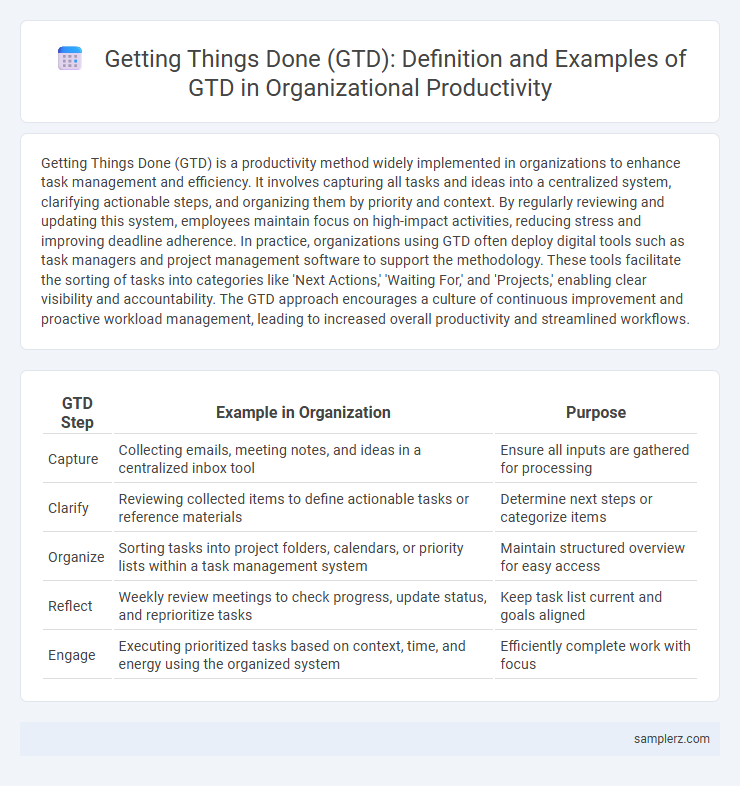Getting Things Done (GTD) is a productivity method widely implemented in organizations to enhance task management and efficiency. It involves capturing all tasks and ideas into a centralized system, clarifying actionable steps, and organizing them by priority and context. By regularly reviewing and updating this system, employees maintain focus on high-impact activities, reducing stress and improving deadline adherence. In practice, organizations using GTD often deploy digital tools such as task managers and project management software to support the methodology. These tools facilitate the sorting of tasks into categories like 'Next Actions,' 'Waiting For,' and 'Projects,' enabling clear visibility and accountability. The GTD approach encourages a culture of continuous improvement and proactive workload management, leading to increased overall productivity and streamlined workflows.
Table of Comparison
| GTD Step | Example in Organization | Purpose |
|---|---|---|
| Capture | Collecting emails, meeting notes, and ideas in a centralized inbox tool | Ensure all inputs are gathered for processing |
| Clarify | Reviewing collected items to define actionable tasks or reference materials | Determine next steps or categorize items |
| Organize | Sorting tasks into project folders, calendars, or priority lists within a task management system | Maintain structured overview for easy access |
| Reflect | Weekly review meetings to check progress, update status, and reprioritize tasks | Keep task list current and goals aligned |
| Engage | Executing prioritized tasks based on context, time, and energy using the organized system | Efficiently complete work with focus |
Understanding GTD: A Brief Overview for Organizations
GTD (Getting Things Done) enhances organizational productivity by streamlining task management and improving workflow clarity. Teams implement GTD by capturing all tasks and commitments in a trusted system, enabling prioritization and focused execution. Adopting GTD principles fosters accountability, reduces stress, and drives consistent progress toward organizational goals.
Key Principles of GTD Applied to Workplace Productivity
Implementing Getting Things Done (GTD) in organizations enhances productivity by capturing all tasks and ideas in a trusted system, ensuring nothing is overlooked. Clarifying actionable steps from collected inputs helps employees focus on clearly defined next actions, reducing overwhelm and improving task execution. Regular review cycles maintain updated task lists and priorities, aligning team efforts with organizational goals and fostering continuous progress.
Setting Up an Organizational GTD System
Setting up an organizational Getting Things Done (GTD) system involves creating a centralized task management platform that captures, clarifies, and organizes all incoming work and projects. Employees and teams consistently use standardized workflows to process emails, meeting notes, and action items into clear next steps, ensuring accountability and progress tracking. Regular review cycles are established to adapt priorities and maintain a transparent overview of commitments at all organizational levels.
GTD Workflow: From Inbox to Actionable Tasks
The GTD workflow transforms organizational inboxes by systematically processing collected inputs into actionable tasks through defined stages of clarifying, organizing, reflecting, and engaging. Each item is reviewed to determine the next physical action, categorized by context or project, and scheduled appropriately to ensure continuous workflow momentum. This method enhances productivity by reducing decision fatigue and maintaining focus on priority tasks within teams.
Real-Life Examples: GTD in Team Meetings
In team meetings, GTD (Getting Things Done) enhances productivity by clearly defining next actions for each participant, ensuring accountability and follow-through. For example, organizations like Microsoft apply GTD principles by capturing all discussion points, clarifying tasks, and delegating responsibilities in real time, which reduces confusion and meeting fatigue. This structured approach helps teams maintain focus on priorities, track progress, and achieve outcomes efficiently.
GTD in Project Management: Streamlining Collaboration
GTD (Getting Things Done) enhances project management by organizing tasks into actionable steps, enabling clearer priorities and deadlines for team members. By systematically capturing, clarifying, and reviewing project components, GTD streamlines collaboration, reduces miscommunication, and accelerates progress toward milestones. Implementing GTD tools like task lists and project folders improves transparency and accountability across departments, optimizing overall productivity within complex projects.
Leveraging GTD Tools and Software in the Office
Leveraging GTD tools and software like Todoist, Trello, and Microsoft OneNote streamlines task management by categorizing actionable items and deadlines efficiently. These platforms enable seamless synchronization across devices, facilitating real-time collaboration and progress tracking within teams. Integrating GTD methodologies into office workflows boosts overall productivity by reducing overwhelm and ensuring commitment clarity.
Measuring Organizational Success with GTD
Implementing Getting Things Done (GTD) in organizations enhances productivity by establishing clear task management and prioritization processes. Measuring organizational success with GTD involves tracking key performance indicators such as project completion rates, employee efficiency, and reduction in missed deadlines. Data from GTD adoption often reveals improved workflow transparency and higher accountability across teams.
Overcoming Common GTD Challenges in Organizations
Implementing Getting Things Done (GTD) in organizations often faces challenges such as inconsistent task capture, lack of standardized workflows, and employee resistance to new productivity habits. Overcoming these hurdles involves establishing clear input channels for task collection, providing comprehensive GTD training, and fostering a culture of accountability through regular reviews. Organizations that integrate digital tools like project management software and automate routine processes see significant improvements in task completion rates and overall productivity.
Case Study: Transforming Productivity with GTD
A leading tech company boosted team efficiency by implementing the Getting Things Done (GTD) methodology, resulting in a 30% increase in project completion rates within six months. Employees reported enhanced clarity and reduced stress through streamlined task management and prioritized workflows. The case study highlights GTD's impact on organizational productivity by fostering accountability and minimizing workflow bottlenecks.

example of GTD in organization Infographic
 samplerz.com
samplerz.com